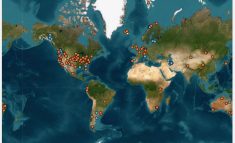Corn yields have increased steadily over the last sixty years, and at a more accelerated pace since 2010. The data informing the most economic nitrogen rate, however, has not kept pace.
Why it matters: Researchers want to know if increasing corn yields are driving nitrogen needs up or down and how environmental factors play a role in order to update the province’s nitrogen calculator for farmers.
According to Adrian Correndo, assistant professor in the University of Guelph’s department of plant agriculture, a better understanding of nitrogen rates in relation to high-yielding modern corn varieties, soil type and weather is needed. Speaking at the 2025 Southwest Agricultural Conference, he discussed some of the studies being used to inform and update Ontario’s Corn Nitrogen Calculator. Fellow assistant plant science professor Joshua Nasielski joined Correndo to highlight considerations for better top-dress nitrogen applications.
Read Also

Packer buys Green Giant, Le Sieur veg brands from U.S. owner
A Quebec-based processor’s deal to buy the Green Giant and Le Sieur packaged and frozen vegetable brands in Canada from a U.S. owner clarifies the status of two popular retail brands grown by Canadian farmers.
Variability is king
Predicting exactly how much nitrogen will be optimal for a corn crop is “a tough thing to do” in any given year, said Correndo, with repeated studies showing the smallest margin of error is around 50 pounds per acre.
However general rules of thumb can be derived over time, including safe volume ranges. Research conducted at the university’s Elora research station, for example, indicated 180 pounds per acre was enough to produce a profitable crop in seven out of ten growing seasons.
“Are we quitting? No. Agronomists are very stubborn,” Correndo said, referring to continued efforts at refining nitrogen rate predictability. The trick is not pursuing better precision under the assumption very small margins of error — say, less than twenty pounds — can always be identified.
“Don’t get obsessed to lose five kilograms, ten kilograms. Those are not going to change the game.”
Updating yield data
What is known are the factors influencing the most economic rate of nitrogen — weather, management, and soil characteristics.
Weather is by far the most significant factor, with Correndo’s research suggesting it’s some three times more impactful than management and soil characteristics. If rainfall is considered alongside recommendations from the Ontario Corn Nitrogen Calculator, for example, Correndo said their research from Elora suggests more nitrogen is necessary due to greater plant growth and mineralization in the soil.
Conversely, there might also be less nitrogen available due to more leaching and other risks.
Then there’s yield. With corn crops commonly averaging over 200 bushels per acre, it’s possible more nitrogen might be needed to sustain and further grow yields.
“One of the criticisms is most of the trials feeding the [Ontario Corn Nitrogen Calculator] recommendations are from 2010 or so. After 2010 we have a huge improvement in yields … Are the higher yields driving the nitrogen needs up, or no?” Correndo said, reiterating data collected since 2010 seems to indicate the most economical rate has indeed gone up.
However, the frequency of warmer and wetter environmental conditions over the same time period makes it harder to verify what factor has, in fact, spurred the change.
Correndo added the connection between yield potential and most economical rate of nitrogen is weak. However, it is present to some degree, and the correlation seems to change based on soil type. Heavy clay soils showing no correlation, for example, while sandy loam soils show about one-half bushel correlation. All these and other data points are continuing to be studied in an effort to update nitrogen recommendations for Ontario growers. Correndo is also currently looking for farmers to partner with on variable rate trials.
Impact of leaf burn
Whatever the most economical nitrogen rate is, Nasielski said post-emergence applications can cause losses through leaf-burn.
Leaf burn happens when water is drawn out of the leaf by urea or ammonia in UAN — the latter having much greater “osmolarity,” or drying potential. The other pathway for leaf burn, Nasielski said, “is this thing called phytotoxicity, which just means that urea and ammonium enter the leaf, they penetrate the leaf, at really high levels of concentration and just kill the tissue.”
Research studying the effect of urea and UAN top-dressed at V10 growth stage indicated yield losses began once leaf burn exceeds six per cent of the leaf surface.
“It’s a one-to-one ratio. You get one per cent leaf burn above the break point [of six per cent] you lose one per cent yield. So, on average, if you get seven per cent leaf damage, you lose one per cent yield,” said Nasielski.
Like the most economical rate of nitrogen, weather also appears to impact leaf burn. Greater damage was observed at trials in Ridgetown, for example, which Nasielski hypothesized was a result of the area experiencing hotter and more humid conditions, as well as less rainfall, around application.
In general, if there is going to be a yield hit from leaf burn, “its going to be bigger the later in season you go.”















